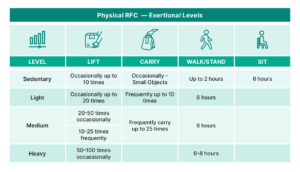Understanding Residual Functional Capacity (RFC) for Social Security Disability Claims
It takes a good understanding of Residual Functional Capacity (RFC) to navigate the Social Security Administration’s (SSA) disability evaluation process. RFC is the foundation for determining whether an individual is “disabled” according to SSA standards. This evaluation measures your capacity to work despite physical, mental, or environmental limitations caused by your condition.
Understanding RFC is important because it directly impacts your eligibility for Social Security Disability Insurance (SSDI) and Supplemental Security Income (SSI). This guide discusses how the SSA uses RFC to decide if you can perform past work, adjust to new work, or qualify for benefits.
What Is Residual Functional Capacity (RFC)?
RFC is an administrative assessment (not a medical diagnosis) that identifies the maximum work-related activities you can sustain given your impairments. The SSA uses RFC to determine the least demanding type of work you can perform—whether it’s your previous job, a sedentary role, or a position with accommodations. Unlike medical diagnoses, RFC focuses on functional limitations (e.g., lifting, standing, concentrating) rather than specific diseases.
Why It Matters: RFC bridges medical evidence and vocational requirements. A well-supported RFC ensures the SSA accounts for how your condition limits your ability to maintain employment.

Components of an RFC Assessment
The SSA evaluates RFC across three categories, as outlined in the SSA’s Program Operations Manual (POMS DI 24510.006) and the Disability Evaluation Under Social Security (Blue Book):
- Physical Limitations:
- Strength/Exertion: Lifting, carrying, standing, walking, or sitting.
- Postural: Climbing, balancing, kneeling, or crouching.
- Manipulative: Reaching, handling, or fine motor skills.
- Mental Limitations:
- Cognitive: Understanding instructions, memory, or decision-making.
- Social: Interacting with supervisors, coworkers, or the public.
- Adaptation: Responding to workplace stress or changes.
- Environmental Limitations:
- Exposure to extreme temperatures, noise, or hazardous conditions.
How the SSA Determines Your RFC
The SSA builds your RFC by weighing all available evidence equally, including:
- Medical Evidence: Doctor’s notes, lab results, imaging (e.g., MRIs), and treatment history.
- Functional Reports: Your descriptions of daily activities (e.g., “I can walk 10 minutes before needing rest”).
- Statements from Others: Observations from family, friends, or caregivers about your limitations.
- Consultative Exams (CEs): Independent evaluations ordered by the SSA if your records are insufficient.
- Vocational Expert (VE) Testimony: Analysis of how your RFC affects job opportunities.
Key Rule: While subjective complaints (e.g., pain, fatigue) are considered, they must be supported by objective medical evidence (e.g., diagnostic tests, clinical findings). For example, chronic pain requires imaging or physician documentation to be factored into your RFC.
RFC Exertional Levels and Non-Exertional Limitations
“Exertional” refers to something caused or made worse by physical activity (“physical exertion”). The SSA classifies physical RFC into exertional categories (see SSA Medical-Vocational Guidelines):
Exertional Level – Definition

Non-Exertional Limitations (e.g., anxiety, vision loss, or difficulty concentrating) are assessed separately and can further restrict your ability to work.
How RFC Impacts Your Disability Claim
The SSA uses RFC alongside the Medical-Vocational Guidelines (Grid Rules) to determine eligibility. These grid rules consider the following:
- Age: Applicants over 50 are more likely to qualify if they lack transferable skills.
- Education: Limited education reduces job adaptability.
- Work Experience: Skills from past jobs that apply to new roles.
Approval Scenarios
- Cannot Perform Past Work: Your RFC prevents you from returning to your previous jobs.
- Cannot Adjust to New Work: Grid rules favor older applicants with limited skills/education.
Denial Scenarios
- RFC Matches Past Work: You can resume your old job.
- Adjustment Feasible: Younger applicants with transferable skills (e.g., computer literacy) may be denied.
Example: A 55-year-old warehouse worker with a sedentary RFC and no computer skills may qualify. A 35-year-old with the same RFC but a college degree may be denied if desk jobs are feasible.
SSDI vs. SSI: How RFC Applies
- SSDI: RFC must show an inability to perform any work (past or new).
- SSI: RFC analysis is identical, but applicants must also meet strict income/resource limits ($2,000 for individuals in 2024).
The medical requirements for both programs are the same.
Common RFC Mistakes to Avoid
- Minimizing Symptoms: Avoid statements like “I can manage” if your capacity is inconsistent.
- Ignoring Non-Physical Limits: Document mental health struggles (e.g., panic attacks).
- Inconsistent Evidence: Conflicting medical opinions weaken your case.
Remember, a well-documented RFC aligned with medical evidence is vital for approval.
Contact Us for a Free Consultation
At Trajector Disability, we understand the complexities of the GRID rules, Residual Functional Capacity, and its impacts. Our team of experts can guide you through the disability application and appeals process. Schedule a free consultation today, and remember, you won’t be charged unless your claim is approved.
Disclaimer: This article is for informational purposes only. SSA rules and RFC criteria may change.
FAQs
How important is my treating physician’s opinion?
The SSA must consider it, but they prioritize objective evidence. Ensure your doctor links limitations to medical findings.
Can I work part-time during the RFC assessment?
Yes, but earnings must stay below SGA limits ($1,620 per month for non-blind individuals, while for blind individuals, it's $2,700 per month). And remember, if you’re capable of earning above SGA on a regular, sustained basis, you will not be approved for benefits.
What if my RFC changes after approval?
Report improvements to the SSA. They may conduct a Continuing Disability Review (CDR): https://www.ssa.gov/ssi/text-cdrs-ussi.htm
Do grid rules apply to mental RFC?
No—they only apply to physical exertional limitations.